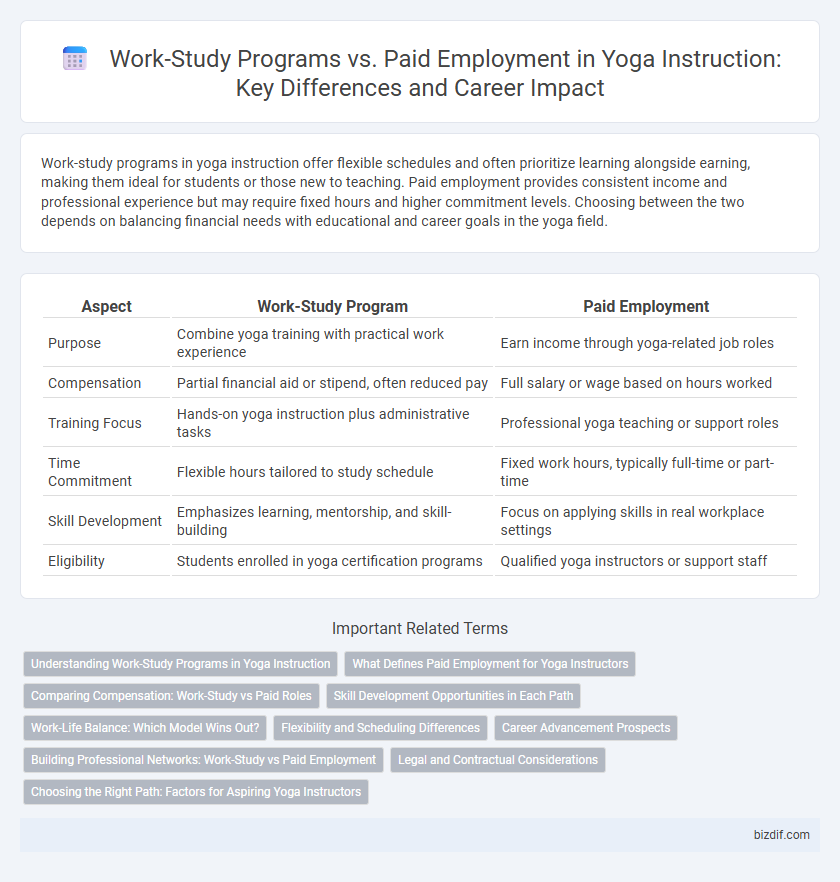Work-study programs in yoga instruction offer flexible schedules and often prioritize learning alongside earning, making them ideal for students or those new to teaching. Paid employment provides consistent income and professional experience but may require fixed hours and higher commitment levels. Choosing between the two depends on balancing financial needs with educational and career goals in the yoga field.
Table of Comparison
| Aspect | Work-Study Program | Paid Employment |
|---|---|---|
| Purpose | Combine yoga training with practical work experience | Earn income through yoga-related job roles |
| Compensation | Partial financial aid or stipend, often reduced pay | Full salary or wage based on hours worked |
| Training Focus | Hands-on yoga instruction plus administrative tasks | Professional yoga teaching or support roles |
| Time Commitment | Flexible hours tailored to study schedule | Fixed work hours, typically full-time or part-time |
| Skill Development | Emphasizes learning, mentorship, and skill-building | Focus on applying skills in real workplace settings |
| Eligibility | Students enrolled in yoga certification programs | Qualified yoga instructors or support staff |
Understanding Work-Study Programs in Yoga Instruction
Work-study programs in yoga instruction provide students with practical teaching experience while offsetting tuition costs through on-campus or partnered studio roles. These programs emphasize skill development and mentorship in yoga techniques, ethics, and class management over immediate financial gain. Paid employment in yoga instruction typically demands prior certification and focuses on revenue generation rather than integrated educational growth.
What Defines Paid Employment for Yoga Instructors
Paid employment for yoga instructors is defined by a formal agreement in which the instructor receives monetary compensation for teaching classes or providing related services. This type of employment typically involves a clear schedule, set responsibilities, and often benefits such as tax withholdings and worker protections. Unlike work-study programs, paid employment requires compliance with labor laws and established payroll systems, ensuring instructors are legally recognized employees.
Comparing Compensation: Work-Study vs Paid Roles
Work-study programs in yoga instruction typically provide financial aid coupled with valuable hands-on experience but offer lower direct monetary compensation compared to paid roles, which deliver consistent wages based on hourly rates or session fees. Paid employment in yoga instruction offers predictable income and often includes benefits, whereas work-study roles prioritize skill development and academic credit over immediate financial reward. Choosing between the two depends on whether immediate earnings or long-term professional growth in yoga teaching is the primary goal.
Skill Development Opportunities in Each Path
Work-study programs in yoga instruction offer hands-on experience under mentorship, enabling skill refinement through direct practice and feedback in real-world class settings. Paid employment typically provides immediate application of teaching skills with a focus on client interaction and class management, fostering professional development through consistent work hours. Both paths enhance skill development, but work-study emphasizes guided learning while paid roles prioritize independent teaching proficiency.
Work-Life Balance: Which Model Wins Out?
Work-study programs in yoga instruction foster a balanced integration of learning and practice, promoting mindfulness that extends beyond the mat and supports mental well-being. Paid employment offers financial stability but can limit flexibility, potentially leading to burnout due to rigid schedules and higher demands. Prioritizing a work-life balance, yoga instructors often find work-study models better align with holistic wellness principles and sustainable career growth.
Flexibility and Scheduling Differences
Work-study programs in yoga instruction typically offer greater scheduling flexibility, allowing students to balance classes and practice sessions alongside their work hours. Paid employment in yoga studios often requires fixed schedules that may not accommodate academic commitments or personal study routines. The flexibility in work-study roles supports a more adaptable learning environment, essential for mastering diverse yoga techniques without conflicting time constraints.
Career Advancement Prospects
Work-study programs in yoga instruction offer hands-on experience and mentorship, fostering skill development and networking opportunities crucial for career advancement. Paid employment provides immediate financial benefits and stability but may limit exposure to diverse teaching techniques and industry connections. Prioritizing work-study can enhance long-term career growth by building a strong professional foundation and expanding potential job prospects.
Building Professional Networks: Work-Study vs Paid Employment
Work-study programs in yoga instruction offer unique opportunities to build professional networks through hands-on experience and mentorship within educational settings. Paid employment often provides broader industry exposure and direct client interactions, expanding professional contacts beyond academic circles. Both pathways contribute to network growth, but work-study emphasizes guided relationship-building while paid roles focus on practical engagement in diverse yoga communities.
Legal and Contractual Considerations
Work-study programs in yoga instruction often involve structured agreements emphasizing educational benefits and limited hours, whereas paid employment requires formal contracts outlining clear wage, tax obligations, and employee rights under labor laws. Legal considerations in work-study settings include compliance with internship regulations and ensuring non-exploitative conditions, while paid roles mandate adherence to minimum wage laws and workplace safety standards. Clear contractual terms in both scenarios protect against liability and clarify responsibilities for instructors, institutions, and students.
Choosing the Right Path: Factors for Aspiring Yoga Instructors
Aspiring yoga instructors should weigh the benefits of work-study programs, which offer immersive learning and mentorship, against paid employment opportunities that provide immediate income and practical experience. Work-study programs typically foster deep skill development and hands-on training essential for teaching confidence. Paid roles can enhance financial stability while building professional networks, making the right choice dependent on individual goals, financial needs, and long-term career aspirations in yoga instruction.
Work-study program vs Paid employment Infographic

 bizdif.com
bizdif.com